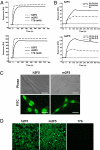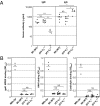Autoreactivity in an HIV-1 broadly reactive neutralizing antibody variable region heavy chain induces immunologic tolerance
- PMID: 20018688
- PMCID: PMC2806760
- DOI: 10.1073/pnas.0912914107
Autoreactivity in an HIV-1 broadly reactive neutralizing antibody variable region heavy chain induces immunologic tolerance
Abstract
We previously reported that some of the rare broadly reactive, HIV-1 neutralizing antibodies are polyreactive, leading to the hypothesis that induction of these types of neutralizing antibody may be limited by immunologic tolerance. However, the notion that such antibodies are sufficiently autoreactive to trigger B cell tolerance is controversial. To test directly whether rare neutralizing HIV-1 antibodies can activate immunologic tolerance mechanisms, we generated a knock-in mouse in which the Ig heavy chain (HC) variable region rearrangement (V(H)DJ(H)) from the polyreactive and broadly neutralizing human monoclonal antibody 2F5 was targeted into the mouse Igh locus. In vitro, this insertion resulted in chimeric human/mouse 2F5 antibodies that were functionally similar to the human 2F5 antibody, including comparable reactivity to human and murine self-antigens. In vivo, the 2F5 V(H)DJ(H) insertion supported development of large- and small pre-B cells that expressed the chimeric human/mouse Igmu chain but not the production of immature B cells expressing membrane IgM. The developmental arrest exhibited in 2F5 V(H)DJ(H) knock-in mice is characteristic of other knock-in strains that express the Ig HC variable region of autoreactive antibodies and is consistent with the loss of immature B cells bearing 2F5 chimeric antibodies to central tolerance mechanisms. Moreover, homozygous 2F5 V(H)DJ(H) knock-in mice support reduced numbers of residual splenic B cells with low surface IgM density, severely diminished serum IgM levels, but normal to elevated quantities of serum IgGs that did not react with autoantigens. These features are consistent with elimination of 2F5 HC autoreactivity by additional negative selection mechanism(s) in the periphery.
Conflict of interest statement
The authors declare no conflict of interest.
Figures






Similar articles
-
Rescue of HIV-1 broad neutralizing antibody-expressing B cells in 2F5 VH x VL knockin mice reveals multiple tolerance controls.J Immunol. 2011 Oct 1;187(7):3785-97. doi: 10.4049/jimmunol.1101633. Epub 2011 Sep 9. J Immunol. 2011. PMID: 21908739 Free PMC article.
-
Common tolerance mechanisms, but distinct cross-reactivities associated with gp41 and lipids, limit production of HIV-1 broad neutralizing antibodies 2F5 and 4E10.J Immunol. 2013 Aug 1;191(3):1260-75. doi: 10.4049/jimmunol.1300770. Epub 2013 Jul 3. J Immunol. 2013. PMID: 23825311 Free PMC article.
-
Identification of autoantigens recognized by the 2F5 and 4E10 broadly neutralizing HIV-1 antibodies.J Exp Med. 2013 Feb 11;210(2):241-56. doi: 10.1084/jem.20121977. Epub 2013 Jan 28. J Exp Med. 2013. PMID: 23359068 Free PMC article.
-
Human Ig knockin mice to study the development and regulation of HIV-1 broadly neutralizing antibodies.Immunol Rev. 2017 Jan;275(1):89-107. doi: 10.1111/imr.12505. Immunol Rev. 2017. PMID: 28133799 Free PMC article. Review.
-
VH replacement in mice and humans.Trends Immunol. 2007 Mar;28(3):132-7. doi: 10.1016/j.it.2007.01.003. Epub 2007 Jan 26. Trends Immunol. 2007. PMID: 17258935 Review.
Cited by
-
DNA vaccine molecular adjuvants SP-D-BAFF and SP-D-APRIL enhance anti-gp120 immune response and increase HIV-1 neutralizing antibody titers.J Virol. 2015 Apr;89(8):4158-69. doi: 10.1128/JVI.02904-14. Epub 2015 Jan 28. J Virol. 2015. PMID: 25631080 Free PMC article.
-
Can immunological principles and cross-disciplinary science illuminate the path to vaccines for HIV and other global health challenges?Philos Trans R Soc Lond B Biol Sci. 2015 Jun 19;370(1671):20140152. doi: 10.1098/rstb.2014.0152. Philos Trans R Soc Lond B Biol Sci. 2015. PMID: 25964461 Free PMC article. Review.
-
Detection and activation of HIV broadly neutralizing antibody precursor B cells using anti-idiotypes.J Exp Med. 2019 Oct 7;216(10):2331-2347. doi: 10.1084/jem.20190164. Epub 2019 Jul 25. J Exp Med. 2019. PMID: 31345930 Free PMC article. Clinical Trial.
-
B cells expressing IgM B cell receptors of HIV-1 neutralizing antibodies discriminate antigen affinities by sensing binding association rates.Cell Rep. 2022 Jun 28;39(13):111021. doi: 10.1016/j.celrep.2022.111021. Cell Rep. 2022. PMID: 35767950 Free PMC article.
-
Breaching peripheral tolerance promotes the production of HIV-1-neutralizing antibodies.J Exp Med. 2017 Aug 7;214(8):2283-2302. doi: 10.1084/jem.20161190. Epub 2017 Jul 11. J Exp Med. 2017. PMID: 28698284 Free PMC article.
References
-
- Mascola JR, et al. Protection of macaques against vaginal transmission of a pathogenic HIV-1/SIV chimeric virus by passive infusion of neutralizing antibodies. Nat Med. 2000;6:207–210. - PubMed
Publication types
MeSH terms
Substances
Grants and funding
LinkOut - more resources
Full Text Sources
Other Literature Sources
Molecular Biology Databases

